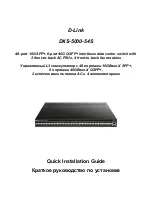
30
C
HAPTER
2: O
PTIMIZING
B
ANDWIDTH
To avoid the potential problem of out-of-sequence packets (or "packet
re-ordering"), the Switch ensures that all the conversations between a
given pair of endstations will pass through the same port in the
aggregated link. Single-to-multiple endstation conversations, on the
other hand, may still take place over different ports.
If the link state on any of the ports in an aggregated link becomes
inactive due to link failure, then the Switch will automatically redirect the
aggregated link traffic to the remaining ports. Aggregated links therefore
provide built-in resilience for your network.
Aggregated Link
Example
The example shown in
Figure 5
illustrates an 4 Gbps aggregated link
between two Switch units.
Figure 5
A 4 Gbps aggregated link between two Switch units
To set up this configuration:
1
Add the 1000BASE-T ports on the upper unit to the aggregated link.
2
Add the 1000BASE-T ports on the lower unit to the aggregated link.
3
Add the GBIC ports on the upper unit to the aggregated link.
4
Add the GBIC ports on the lower unit to the aggregated link.
5
Connect the 1000BASE-T port marked ‘Up’ on the upper Switch to the
1000BASE-T port marked ‘Up’ on the lower Switch.
Switch 4228G
4 Gbps Aggregated Link
Switch 4228G
Summary of Contents for SuperStack 3C17300
Page 12: ...14 ...
Page 30: ...32 CHAPTER 2 OPTIMIZING BANDWIDTH ...
Page 36: ...38 CHAPTER 3 USING MULTICAST FILTERING ...
Page 45: ...How STP Works 47 Figure 11 STP configurations ...
Page 76: ...78 ...
Page 80: ...82 APPENDIX A CONFIGURATION RULES ...
Page 86: ...88 APPENDIX B NETWORK CONFIGURATION EXAMPLES ...
Page 102: ...104 GLOSSARY ...
















































